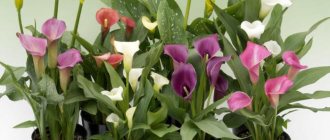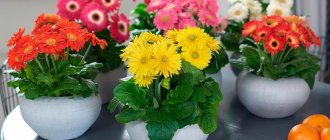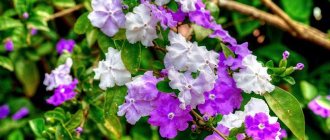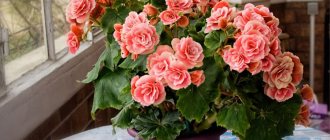Asia Minor is considered the homeland of ranunculus. Culture from the Buttercup family. And the plant itself is often called that: Asian buttercup. It is not yet very common in gardens in Russia and neighboring countries. But those who see these flowers for the first time fall in love forever with these bright double half-peonies and half-roses.
Author of the article
Maxim Sverchkov
Professional biologist and breeder with extensive experience and experience.
There are up to 600 species in the Buttercup family, growing on all continents except Antarctica. Alpine buttercup is used in landscape design. But for creating decorations and compositions, the Asian buttercup, or ranunculus, is preferred. From Latin the translation is “frog”, apparently because the plant loves swampy places.
What does ranunculus or buttercup look like?
Although, perhaps, every person has heard about buttercup, not everyone knows its description.
Ranunculus is a real flowerbed decoration
Which family does it belong to?
Buttercup (ranunculus) is part of the Buttercup family, which, according to various sources, includes from 1200 to 2000 different plants. Representatives of this family are found in almost the entire northern hemisphere - from temperate latitudes to the Arctic. Moreover, in these parts you can see about 13 genera of flowers!
Briefly about the history of appearance
Ranunculus are flowers that have been well known to mankind for thousands of years. Even in the works of the ancient scientist Pliny there are references to this elegant plant.
This is interesting! From Latin, the name of the flower is translated as “frog” - and all because it is often found on swampy soils.
Initially, its homeland was Iran and Syria, but over time it became popular among Europeans, and then spread throughout Europe. Later it went out of fashion, but in recent years florists have become interested in it again and are actively developing new varieties.
Plant characteristics
This is a fairly extensive genus, so the flowers in it differ greatly from each other.
On average, their height ranges from 20 to 80 cm. The plant grows well both in pots and in open ground. The shoots are very similar to dahlias - both stems and leaves. The roots have an interesting shape - they look like crow's feet.
The flower is perfect for bouquets
When the flower just begins to open, it looks like a rose. Well, fully opened buds look more like an elegant poppy. The similarity is enhanced by the color - most varieties have deep orange or red flowers.
On a note! Some types of ranunculus are used in folk medicine to treat skin diseases.
The plant is perennial. That is, having planted a tuber in the garden once and creating optimal conditions for growth, a flower lover can be sure that every year the plant will delight him with gorgeous blooms.
A modest buttercup with an exotic appearance
The Buttercup family includes more than 600 species, its representatives are found on all continents except Antarctica. For lovers of rock gardens and rockeries, the high-mountain alpine buttercup is of interest, but the garden or Asian ranunculus buttercup has the greatest decorative value. Based on its natural habitat in Asia Minor and southeastern Europe, it is also called Syrian.
This is a perennial herbaceous plant growing in a single stem up to half a meter high. Unlike other species, ornamental ranunculus reproduces by tuberous roots that look like small crabs or spiders. The leaves are emerald green, tripartite, pubescent, succulent, which gives the plant fragility. Each tuber produces up to 4 peduncles, forming from 1 to 10 flowers with a diameter of 4–7 cm, collected in beautiful lush bouquets. The palette amazes with the variety and richness of shades - red, yellow, white, crimson, orange, purple.
Ranunculus is perennial, like most tuberous crops, ephemeral. Its life cycle can be divided into several periods:
- vegetation, including flowering (spring-summer);
- death of the above-ground part - ripening of the tuber (beginning of autumn);
- dormant period - laying flower buds for the next year;
- resumption of vegetation.
Garden forms of decorative culture were known back in the 16th century. Modern selection is aimed at obtaining large flowers, expanding the color gamut, increasing the duration of flowering, and breeding border varieties.
Classification of ranunculus species
Calla flowers - growing and care at home
It is impossible to list all types of plants in one article - their number exceeds four hundred. But the most interesting ones are worth considering.
Asian group
Asian buttercup is a very beautiful plant. This is a herbaceous perennial 40-45 cm high. The stem can be either straight or branched. The leaves are covered with elegant down. The flowers are medium-sized - from 3 to 5 cm, and they will delight the grower with a rich range of colors: orange, pink, yellow, red.
Persian group
Externally, Persian buttercups are similar to Asian ones, differing only in flowers and stems. The latter are quite short. But the flowers are very elegant - they are found with both simple and elegant double petals.
French group
These plants are of medium height and have distinct bare stems. The flowers are semi-double, with fluffy petals giving them a ball shape.
African group
They are also known as turban-shaped ones. They can boast of the largest flowers - spherical, densely double. It is not surprising that many gardeners prefer them.
Varieties that are most popular with gardeners
Amaryllis flowers - home care
Florists have developed hundreds of varieties of the flower. The most interesting varieties:
- Bloomingdale's. A miniature plant, perfect for growing in a pot. The height is about 25 cm and large flowers distinguish it from a number of numerous relatives.
- Color Carnival. Very tall plants - up to 70 cm. Double flowers, of different colors - from yellow to dark pink. Perfect for making elegant bouquets.
- Superbissima. Another variety intended for cutting. The stems are long and the petals are semi-double. This variety contains white and red ranunculus.
How does ranunculus reproduce?
Gloxinia flowers - home care
To figure out how to plant ranunculus, you should learn about the methods of its propagation, as well as study the theory.
Growing from seeds
This option is more common - seeds are usually easier to acquire than bulbs. But you will have to wait much longer for the first flowers - several months are lost, so in the first year when grown in open ground you may not see them. Therefore, experts recommend using seedlings.
The variety of cultural shades is amazing
Time to board
The optimal time for planting is mid-February. Then, by early to mid-May, the seedlings will have grown and become strong enough to be planted in open ground.
Selection of capacity
The root system of buttercups develops quite quickly, so a pot or other container needs to be quite large and deep. It is important not to forget about drainage at the bottom and holes for draining excess water - otherwise the roots will begin to rot.
Preparing soil and seed
The optimal soil is obtained from soil and peat - they need to be taken in equal proportions. It is advisable to use soil from the area where the flowers will grow in the future, so that they immediately get used to it.
On a note! When growing crops in flowerpots, you can plant up to five plants together - they will form a beautiful bouquet.
First, the seeds are soaked in warm water, tinted with potassium permanganate for disinfection. The floating seeds can be removed immediately - they probably will not sprout. However, not all of those who remain will rise. Even under ideal storage conditions, germination rarely exceeds 30%.
Seedling care
15-20 days after planting, the first shoots will appear in the pot. They need to be covered with glass or polyethylene and protected from direct sunlight, sometimes moistening the soil with a spray bottle. The optimal temperature is from +18 to +23 degrees.
Dive and transfer
After throwing out the fourth sheet, you need to pick. The soil is abundantly moistened, the plants are separated and planted in separate containers. Peat pots are best suited.
Planting by seeds
In this case, flower stalks appear only after a year. Not all seeds can germinate. They must be collected from faded buds. For this purpose gauze is used. To plant the material, you need to prepare a container with loose soil.
The seeds are placed in a container, sprinkled with soil and covered with film. The container is placed in a bright room, the temperature in which is +15 ºC. You should wait until the first leaves appear, then the plants are transplanted into separate pots.
Features of garden care
Growing a ranunculus flower in open ground, planting and caring for which is not difficult, still requires some mandatory procedures.
What conditions do buttercups like?
In order for a plant to grow actively and begin to bloom as quickly as possible, it needs soil with the following characteristics:
- neutral pH;
- fertile (chernozem or sandy soil mixed with compost);
- well drained;
- light.
What is the plant afraid of?
It is not enough to know how to plant buttercups with roots - it is equally important to have an idea of what conditions are not suitable for them. The plant really does not like heavy loamy soils - on them the root system receives little air and begins to rot.
Ranunculus tubers
Watering
The crop needs to be watered often, but little by little. Usually it is enough to moisten the soil from above, but on hot days watering should be more abundant.
Mulching
Suitable materials for mulching would be pine or leaf humus. A thick layer is not needed - 2-3 cm is enough.
Loosening
In order for air to pass freely to the roots of the plant, it is necessary to regularly loosen the soil. This is true for medium soils. On light, sandy soils, you can do this once or twice a season, for example, in the spring and before flowering begins.
Feeding
From mid-May to mid-June, you need to feed them every two weeks with nitrogen fertilizers, and during flowering - with phosphorus-potassium fertilizers.
Transfer
To do this, you need to dig up a piece of earth about 30x30x30 cm in size and, together with the plant, transplant it to a new place, after which the crop is abundantly watered and mulched. If everything is done correctly, then the buttercup will not even hurt and will immediately begin to grow.
A worthy decoration for a windowsill
Possible problems in growing
When growing ranunculus, difficulties may arise for which you need to prepare in advance.
Pests
The most common problems are caused by spider mites, slugs, aphids and snails. The means of control are standard - preparations for them can be bought at any flower shop.
Diseases
Of the diseases, buttercups are most susceptible to powdery mildew and fusarium wilt. The problem is solved with the help of special fungicidal preparations.
Signs of improper care
In general, ranunculus is a rather unpretentious plant. The only thing he doesn't tolerate well is elevated temperatures. With it, it grows slowly and sometimes stops blooming.
Diseases and pests
Buttercups are very resistant to various diseases and pests. If you care for the plants incorrectly, for example, too much watering, then root rot may appear. In addition, if the summer season is too wet, these perennial flowers can be affected by powdery mildew, and the leaves can attract annoying cabbage butterflies. In this case, bioinsecticidal preparations can be used against pests.
Cabbage Butterfly










